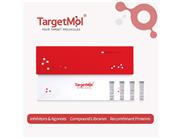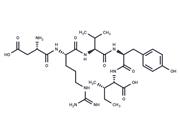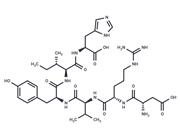| Name | Angiotensin II (3-8), human |
| Description | Angiotensin II (3-8), human, is a less effective agonist at the angiotensin AT1 receptor. |
| Animal Research | Eight weeks after bilateral CCA ligation surgery, rats were anaesthetized with 10% chloral hydrate and placed in a stereotactic frame. The scalp was reflected under sterile surgical conditions. A brain-infusion cannula coupled via vinyl tubing to an osmotic pump was implanted into the third cerebral ventricle by surgeons who were blinded to the experimental groups. Osmotic pumps were placed subcutaneously between the scapulae and used to infuse two doses of Ang IV (20 nM, 0.15 μl/h and 100 nM, 0.15 μl/h), divalinal-Ang IV (500 nM, 0.15 μl/h) or aCSF (0.15 μl/h) into the third cerebral ventricle, lasting for six weeks. Following this surgery, the wounds were carefully closed with sutures[1] |
| In vivo | Rats with CCH exhibited higher levels of Aβ42, p-tau and pro-inflammatory cytokines in the brain when compared with controls. Infusion of Ang IV significantly reduced the expression of pro-inflammatory cytokines in the brains of rats with CCH. Meanwhile, the reduction of pro-inflammatory cytokines levels caused by Ang IV was reversed by divalinal-Ang IV. During the treatment, the SBP in rats was not significantly altered[1] |
| Storage | keep away from moisture | Powder: -20°C for 3 years | In solvent: -80°C for 1 year | Shipping with blue ice. |
| Keywords | Angiotensin II (3 8), human | inhibit | Angiotensin II (3-8), human | Inhibitor | Angiotensin II (38), human | Angiotensin Receptor | Angiotensin II , human |
| Inhibitors Related | Tranilast | Enalapril Maleate | Azilsartan Methyl Ester | Sacubitril/Valsartan | Azilsartan | Irbesartan | Losartan | Ramipril | Captopril | Valsartan Methyl Ester |

 United States
United States



